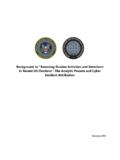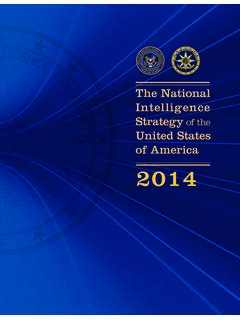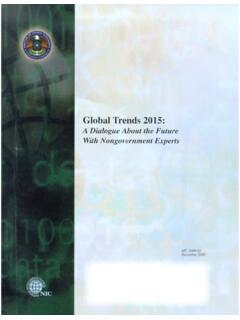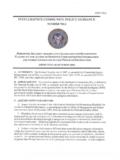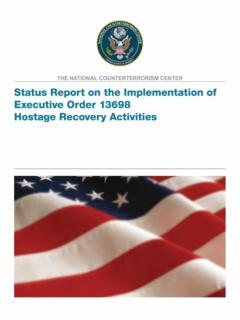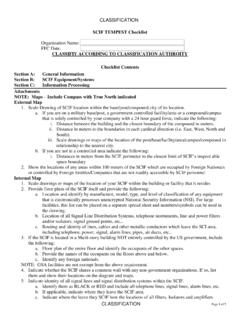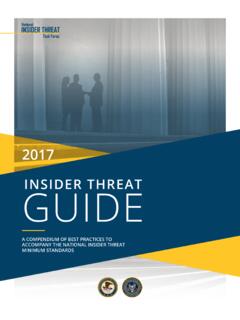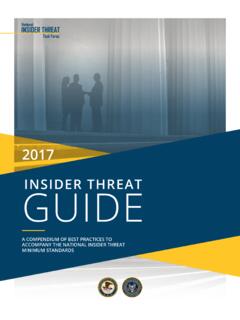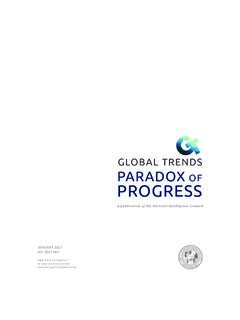Transcription of Worldwide Threat Assessment - dni.gov
1 Statement for the Record Worldwide Threat Assessment of the US Intelligence Community Senate Select Committee on Intelligence Daniel R. Coats Director of National Intelligence May 11, 2017. STATEMENT FOR THE RECORD. Worldwide Threat Assessment . of the US INTELLIGENCE COMMUNITY. May 11, 2017. INTRODUCTION. Chairman Burr, Vice Chairman Warner, Members of the Committee, thank you for the invitation to offer the United States Intelligence Community's 2017 Assessment of threats to US national security. My statement reflects the collective insights of the Intelligence Community's extraordinary men and women, whom I am privileged and honored to lead. We in the Intelligence Community are committed every day to provide the nuanced, multidisciplinary intelligence that policymakers, warfighters, and domestic law enforcement personnel need to protect American lives and America's interests anywhere in the world.
2 The order of the topics presented in this statement does not necessarily indicate the relative importance or magnitude of the Threat in the view of the Intelligence Community. Information available as of April 24, 2017 was used in the preparation of this Assessment . i TABLE OF CONTENTS Page GLOBAL THREATS. Cyber Threat 1. Emerging and Disruptive Technologies 3. Terrorism 4. Weapons of Mass Destruction and Proliferation 6. Space and Counterspace 8. Counterintelligence 9. Transnational Organized Crime 10. Economics and Natural Resources 12. Human Security 13. REGIONAL THREATS. East Asia 16. China 16. North Korea 16. Southeast Asia 17. Russia and Eurasia 18. Russia 18. Ukraine, Moldova, and Belarus 19. The Caucasus and Central Asia 19.
3 Europe 20. Key Partners 20. Turkey 20. Middle East and North Africa 21. Syria 21. Iraq 22. Iran 23. Yemen 24. ii South Asia 24. Afghanistan 24. Pakistan 24. India-Pakistan 25. Sub-Saharan Africa 25. South Sudan 25. Sudan 25. Nigeria 26. Sahel 26. Somalia 26. Ethiopia 26. Democratic Republic of the Congo 26. Western Hemisphere 27. Mexico 27. Central America 27. Colombia 27. Cuba 27. Venezuela 28. iii GLOBAL THREATS. CYBER Threat . Our adversaries are becoming more adept at using cyberspace to threaten our interests and advance their own, and despite improving cyber defenses, nearly all information, communication networks, and systems will be at risk for years. Cyber threats are already challenging public trust and confidence in global institutions, governance, and norms, while imposing costs on the US and global economies.
4 Cyber threats also pose an increasing risk to public health, safety, and prosperity as cyber technologies are integrated with critical infrastructure in key sectors. These threats are amplified by our ongoing delegation of decisionmaking, sensing, and authentication roles to potentially vulnerable automated systems. This delegation increases the likely physical, economic, and psychological consequences of cyber attack and exploitation events when they do occur. Many countries view cyber capabilities as a viable tool for projecting their influence and will continue developing cyber capabilities. Some adversaries also remain undeterred from conducting reconnaissance, espionage, influence, and even attacks in cyberspace. Cyber Threat Actors Russia.
5 Russia is a full-scope cyber actor that will remain a major Threat to US Government, military, diplomatic, commercial, and critical infrastructure. Moscow has a highly advanced offensive cyber program, and in recent years, the Kremlin has assumed a more aggressive cyber posture. This aggressiveness was evident in Russia's efforts to influence the 2016 US election, and we assess that only Russia's senior-most officials could have authorized the 2016 US election-focused data thefts and disclosures, based on the scope and sensitivity of the targets. Outside the United States, Russian actors have conducted damaging and disruptive cyber attacks, including on critical infrastructure networks. In some cases, Russian intelligence actors have masqueraded as third parties, hiding behind false online personas designed to cause the victim to misattribute the source of the attack.
6 Russia has also leveraged cyberspace to seek to influence public opinion across Europe and Eurasia. We assess that Russian cyber operations will continue to target the United States and its allies to gather intelligence, support Russian decisionmaking, conduct influence operations to support Russian military and political objectives, and prepare the cyber environment for future contingencies. China. We assess that Beijing will continue actively targeting the US Government, its allies, and US. companies for cyber espionage. Private-sector security experts continue to identify ongoing cyber activity from China, although at volumes significantly lower than before the bilateral Chinese-US cyber commitments of September 2015.
7 Beijing has also selectively used offensive cyber operations against foreign targets that it probably believes threaten Chinese domestic stability or regime legitimacy. Iran. Tehran continues to leverage cyber espionage, propaganda, and attacks to support its security priorities, influence events and foreign perceptions, and counter threats including against US allies in the region. Iran has also used its cyber capabilities directly against the United States. For example, in 1. 2013, an Iranian hacker conducted an intrusion into the industrial control system of a US dam, and in 2014, Iranian actors conducted a data deletion attack against the network of a US-based casino. North Korea. Pyongyang has previously conducted cyber-attacks against US commercial entities.
8 Specifically, Sony Pictures Entertainment in 2014 and remains capable of launching disruptive or destructive cyber attacks to support its political objectives. Pyongyang also poses a cyber Threat to US. allies. South Korean officials have suggested that North Korea was probably responsible for the compromise and disclosure of data in 2014 from a South Korean nuclear plant. Terrorists. Terrorists to include the Islamic State of Iraq and ash-Sham (ISIS) will also continue to use the Internet to organize, recruit, spread propaganda, raise funds, collect intelligence, inspire action by followers, and coordinate operations. Hizballah and HAMAS will continue to build on their cyber accomplishments inside and outside the Middle East.
9 ISIS will continue to seek opportunities to target and release sensitive information about US citizens, similar to their operations in 2015 disclosing information about US military personnel, in an effort to inspire attacks. Criminals. Criminals are also developing and using sophisticated cyber tools for a variety of purposes including theft, extortion, and facilitation of other criminal activities. Ransomware, malware that employs deception and encryption to block users from accessing their own data, has become a particularly popular tool of extortion. In 2016, criminals employing ransomware turned their focus to the medical sector, disrupting patient care and undermining public confidence in some medical institutions.
10 Physical Consequences Our adversaries are likely to seek capabilities to hold at risk US critical infrastructure as well as the broader ecosystem of connected consumer and industrial devices known as the Internet of Things (IoT). Security researchers continue to discover vulnerabilities in consumer products including automobiles and medical devices. If adversaries gain the ability to create significant physical effects in the United States via cyber means, they will have gained new avenues for coercion and deterrence. For example, a cyber attack on a Ukrainian power network in 2015 caused power outages for several hours. Economic and Security Consequences Adversaries will continue to use cyber operations to undermine US military and commercial advantage by hacking into US defense industry and commercial enterprises in pursuit of scientific, technical, and business information.
